#maria foote
Explore tagged Tumblr posts
Text
The Castlevania franchise feels like it's getting more and more divided since Netflixvania started and it's getting really bloody frustrating to the point that while watching Nocturne I've felt disquieted, and I think I've realised why that is.
It's the fucking DmC:Devil May Cry white hair fiasco all over again.
For those that don't know, when the DmC reboot was revealed people had a lot of criticism, including turning Dante from a cool but likeable hero into a foul mouthed smoker, the dumbing down of the gameplay, the antagonism towards the fanbase, and turning his iconic white hair black. Of all these criticism, only the hair colour change was given any attention, painting the fan base in a very negative light and side stepping the real issues people had by only focusing on the cherry rather than the whole sundae.
All this attention directed towards something that in the grand scheme of things is very minor but it gets all the attention while the bigger stuff is ignore.
Yes, there are people mad about the show for racist reasons and they shouldn't be listened to, but there are genuine complaints that are being swept up with that.
The character changes have a sort of domino effect on everything. Maria being a serious revolutionary is interesting, but I saw someone put it best that what made her special was the fact that she was a little girl in a world of classic horror that believed she was in a fairy tale and had the power to force that reality on everyone else. Netflix Maria is good, but lacks the charm of Maria.
youtube
The second example is Juste. When I saw him I was very excited, but that was mainly because it was acknowledgement of the original canon than anything else. His magical prowess, the thing that makes him stand out among the Belmont linage, is mentioned and then brushed aside, and the worst ending of his game is what is taken as canon. And once Richter gets his magic back, Juste is gone. He feels like a plot point rather than the character. I sympathise with people who's favourite game was Harmony of Dissonance.
Annette was a compelling character with a well developed story, but anyone that says her original characterisation would never work are being disingenuous because they literally did that, except that did so with Tera. The connections to Richter and Maria, the damsel elements, the fact she gets turned into a vampire, all from Annette. Swapping them around wouldn't work for multiple reasons and I'm not going to say I can do better than people you get paid to write when I don't, but I feel I can say that if they had wanted to they could have done something closer to the original while still touching on the themes and narratives they wanted to.
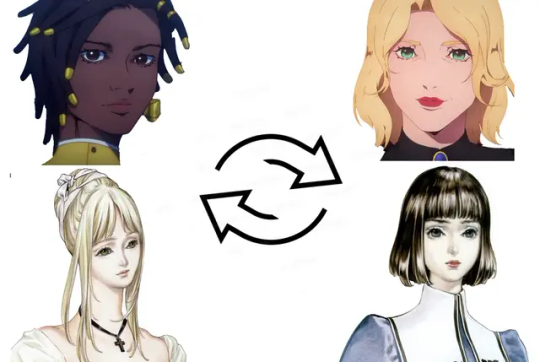
Olrox... honestly the only criticism I can really think of is the removal of any reference to Count Orlock.
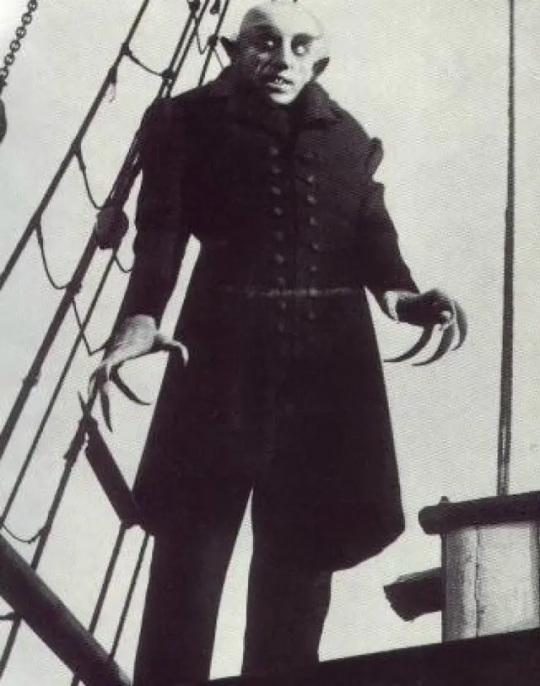
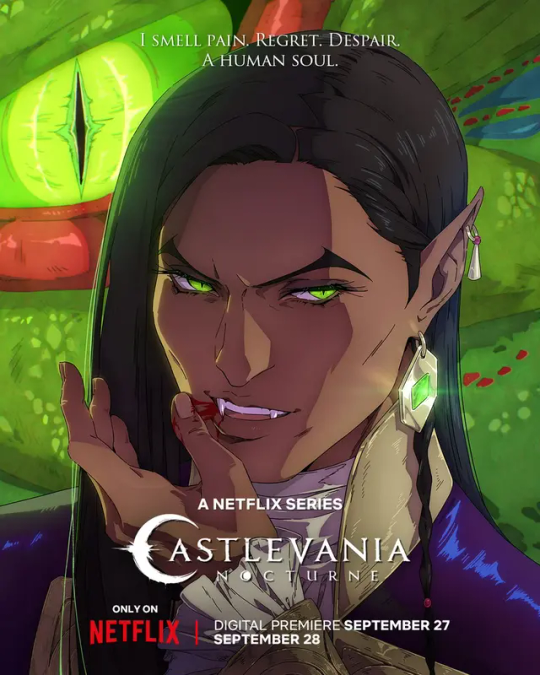
There's an elitism with both sides of the fanbase here. On the Netflix side, there's the feeling that since theirs is more popular that any criticism is because people are just nostalgic, and game fans feel that since theirs is the original foundation that anyone that doesn't agree with them is just a new fair-weather fan. And honestly, I'm more sympathetic to the game fans.
I've seen Netflixvania fans look at people complaining that the character have changed and go "yeah well the version you like sucks so you should just grow up" As if that's going to make everything better. And all the people complaining about the race changes or posting "WOKE?!?!?!" have poisoned the well for any actual discussion about this, not helped by the social media accounts deliberately stoking the flames in the mistaken belief that all publicity is good publicity, which raised the ire of nexflixvania creators. Unfortunately marketing can often be removed from the intentions of the creators.

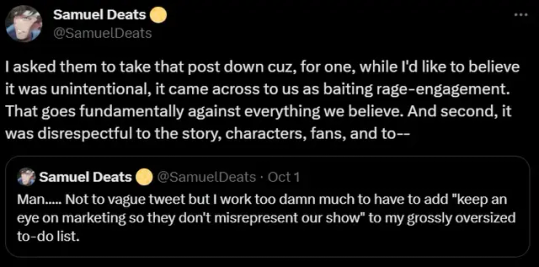
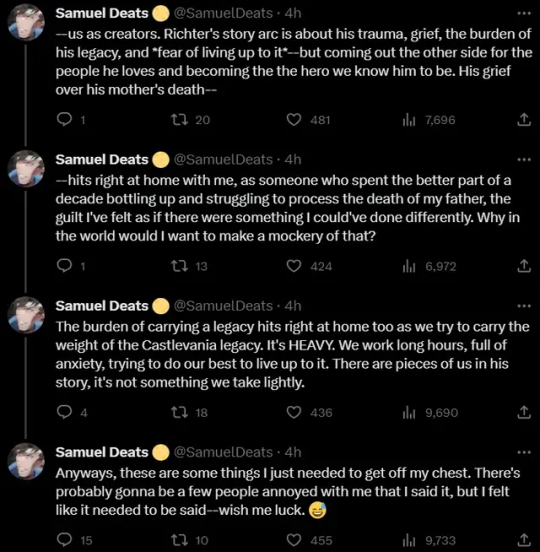
Yes, Netflixvania is a great show, with beautiful animation and great storytelling, but it's not perfect and as an adaptation is leaves a lot to be desired. And that's the crux of it! The show is good, really good! But it doesn't feel like an adaptation of Castlevania. It's just a bunch of little details that pile up to make it less of what the game fans liked about the series. It's more grimdark horror than classic horror. It's more crude than it is philosophical. It's more hopeless than it is hopeful. And regardless of what you individually think, that's what people have liked about Castlevania for almost 40 years.
Ultimately I just have to ask, why do people seem to assume that you can't make a faithful adaptation while also making it interesting? They're not mutually exclusive.
#castlevania#castlevania nocturne#castlevania netflix#netflix#animation#adaptation#richter belmont#maria renard#annette#tera#dracula#alucard#olrox#honestly I feel I personally wouldn't be as disquieted if they had just kept dracula the villain#sort of shot themselves in the foot on that one#not because its inherently bad but because it fucks up the rest of the series#but seriously people need to chill the fuck out here#just because the show is good doesn't invalidate people that like the game#a good adaptation doesn't mean it can't also be a good story#probably going to piss people off#but i'm tired of this stupid distraction from real criticism people have#just because something is good doesn't mean people can't criticise it#and anyone feeding the fire is a tar pit#castlevania hot take#apparently that's a recurring tag now#god I hope this doesn't blow up in my face#as someone that's a fan of Devil May Cry I'm just praying that the series isn't messed around with#if they make dante a pottymouth then I'm going to combust#That's Nero's thing leave dante out of it#dmc
122 notes
·
View notes
Text
I've started to write little medieval jingles in my head while trying to fall asleep, so do with that information what you will
#jingles as in silly little songs that foot soldiers might sing#it's for a fic i will eventually work more on lol. (for fool's gold)#all i have of the song so far is that it's from the perspective of a traveller looking for his lady#but he can't remember her name or her face because he fucks so much#so the other characters shout out different names at different points in the song#it's dumb af but i'm having fun ok#and now you can read “maria! sofia! the lovely pampinea!” and hear the tune of 1985 like me ajdnfkwgj#in the context of the fic this was nicolo's idea. and the twist ending is that the lady is actually a man and he forgot or smth#OR OR a suggestion from my partner: the only way the traveller can identify his lady is by her ass AJAMFNSKHKDJV#that is so medieval im dying
126 notes
·
View notes
Text
Maria Zhelezko pt. 59
71 notes
·
View notes
Text
thinking about the part in the most recent twitter takeover where sonic calls commander tower who very awkwardly invites shadow over to dinner to meet his grandchild . did they think nobody would notice that they already did that in shadow 05 or is the implication here that shadow never went to that first dinner so the commander just keeps inviting shadow to his house over and over until he finally shows up
#okay well actually now that im thinking back on the specific wording of the dialogue in shadow 05#i dont think any solid plans were made he just said he was thinking of inviting shadow over#but whatever#the commander wanting to make amends with shadow after all thats happened between them makes sense but its still funny#like the fact that he did that immediately after trying to kill shadow and blaming him for maria's death#the fact that at the time this is happening shadow either barely remembers who he is or doesnt remember at all#though him remembering clearly would also make it pretty funny#imagine waking up from a 50 year nap not having aged at all and the kid who was mean to you and called you a freak#is suddenly an old man whos straight up trying to kill you now . and then you save the world#and hes like ohh sorry about all that . do you wanna come over to my house .#imagine abe's wife's perspective here imagine your husband brings over the ultimate lifeform for dinner . and hes a 3 foot tall hedgehog
16 notes
·
View notes
Note
jessmaria for the ship game
love. obsessed. already wrote two fics about them and have more in my brain because i can't stop thinking about them. girlfriends that flop together stay together. or something. i think the timing of their individual successes are fascinating. girlfriends that lose to igaryna together stay together. we talk about them being parallels but metaphorically i think they are reflections of each other. not parallel. there was maybe an intersection, point in time when they were equals. or like two cars passing on the highway at night. you can see the headlights from a long way off but there's only a millisecond you actually spend in the same general vicinity. the rest is either squinting into the headlights ahead or craning your neck to look behind.
#anyways............#like they *are* parallels but also i think one of the most important things about their dynamic is the offset#unequal footing. maria was more successful then & jess is more successful now.#craning your neck to look to see what the other person is doing#or staring at them and wondering if that was you before or if that will be you after
7 notes
·
View notes
Text

Yeah so we bring a Catholic vibe to the function and there's nothing y'all can do about it xxx!
It's just us and our Catholicism against the world
#literally all of them were opposed with catholicism as at least one of the reasons#charlie wasn't catholic though - but he was surrounded by them which no one liked#and catherine got accused of treason once which only was stopped by charlie 2 putting his foot down and defending her no matter what#tudors#tudor memes#stuartposting#stuarts#stuart memes#catholicism#mary i#mary queen of scots#charles i#henrietta maria#henrietta maria of france#charles and henrietta#catherine of braganza#james ii#maria beatrice d'este#mary of modena#history#history humour#we have a pretty witty queue
7 notes
·
View notes
Text


8 notes
·
View notes
Text
here we have Ludwig being a stupid dumbass and forgetting to look mean



i forgive him.
#ludwig the holy blade#lady maria of the astral clocktower#bloodborne#My 9 foot horse girl boyfriend who is totally real#My 7 foot lesbian girlfriend who is totally real#He’s so stupid but I love him so much#Maria and Ludwig friendship goes hard#I put the eye patch on the wrong eye but it’s okay it’s 2 am
32 notes
·
View notes
Photo
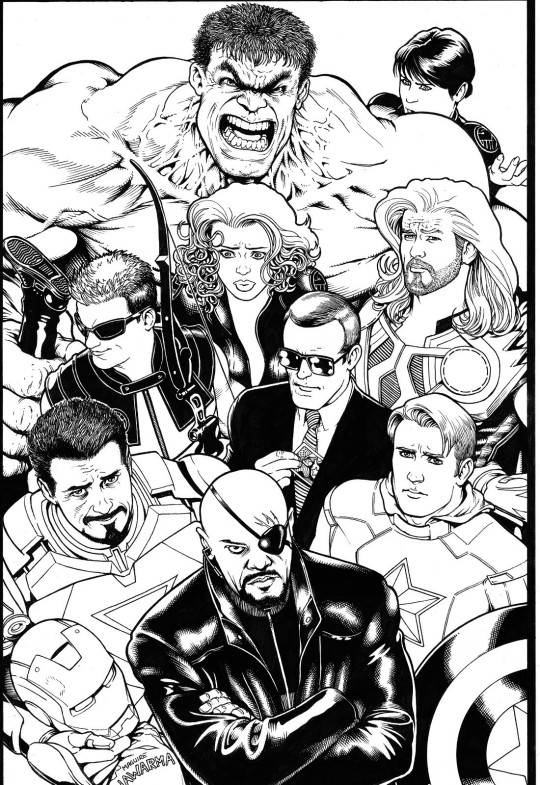
The cast of The Avengers (2012) by Kevin Maguire.
#The Avengers#Hulk#Maria Hill#Loki (foot only)#Hawkete#Black Widow#Thor#Phil Coulson#Iron Man#Captain America#Nick Fury#Marvel Comics#MCU#Marvel Studios#Kevin Maguire
56 notes
·
View notes
Text
thinking about the millers tying maria’s snow boots for her when she gets too pregnant to reach her laces 😭🫶🏾
#pregnancy pass#she just holds her foot our to joel with her loose shoes like 🦶🏾🥾 can u help me#**out sorry#hes like sure thing darlin#it reminds him of tying sarah’s shoes for her when she was too young to know how#okay i gotta stop now im hurting my own feelings#joel and maria best friend agenda#the millers#maria miller#joel miller#tommy miller#ellie williams#ellie would roll her eyes SO hard but lowkey gets salty when shes around and maria doesnt ask her#tommy loves doing it ofc bc he gets to kiss the tummy#the tipsy bison#tlou#tlou headcanons#tlou hbo#tlou hc
12 notes
·
View notes
Text
still not quite sure what actually happened during the whole pool of pandemonium sequence with the dark figure lowkey
the soul riders ask afterwards who you see but i didnt see anyone in particular?? was that intentional??? i wasn't sure what the game wanted me to do so i ran towards it and it vanished. never got explained to me but i have the perception skills of a worm so idk wtf just happened. maybe it was important maybe it wasn't
#i was on call with a friend at the time so all they could hear was confused exclamations#and my dumb little song abt having to run on foot so much (i had been back and forth through fort maria library at that point#i always manage to miss one crucial bit of information that never gets brought up again 💀#sso#star stable#ssoblr#sso spoilers#sso story quests#sso story quests spoilers
20 notes
·
View notes
Text
By Rachel May
Rachel May, English professor and author, came upon Elizabeth Wagner Reed’s book about a decade ago, on Reed’s daughter’s website.
Published April 22, 2023Updated April 24, 2023, 10:50 a.m. ET
This article is part of Overlooked, a series of obituaries about remarkable people whose deaths, beginning in 1851, went unreported in The Times.
In 1992, the geneticist Elizabeth Wagner Reed self-published “American Women in Science Before the Civil War,” a book highlighting 22 19th-century scientists. One of them was Eunice Newton Foote, who wrote a paper on her remarkable discovery about greenhouse gases, “a phenomenon which is of concern to us even now,” Reed wrote.
Foote was forgotten soon after the paper was read aloud by a male scientist at a conference in 1856 and published the following year. A male scientist was eventually credited with the discovery.
Like Foote, Reed herself fell into obscurity, a victim of the erasure of female scientists that the historian Margaret Rossiter coined the Matilda Effect — named for the sociologist Matilda Joslyn Gage, whose 1870 pamphlet, “Woman as Inventor,” condemned the idea that women did not have the skills to succeed in the field.
Reed, however, made significant contributions to the sciences.
She wrote a landmark study about intellectual disability genetics, helped found a field of population genetics and wrote many more papers on botany, the biology of women and sexism in science.
Reed persisted in her research even when she found herself a widow with a toddler during World War II. By the time of her death, in 1996, in spite of publishing more than 34 scholarly papers, public school curriculums and two books, the record didn’t bend in her favor. It wasn’t until 2020, when the scientist and scholar Marta Velasco Martín published a paper on Reed, that her legacy was resurrected.
Reed was born Elizabeth Wagner on Aug. 27, 1912, in Baguio, in what was then called the Philippine Islands, to Catherine (Cleland) and John Ovid Wagner. John was from Ohio and worked in construction there at the time; Catherine, from Northern Ireland, was working in the Philippines as a nurse.
The family later settled on a farm in Ohio, where Elizabeth grew up picking raspberries “from dawn to dusk,” her son William Reed said in a phone interview.
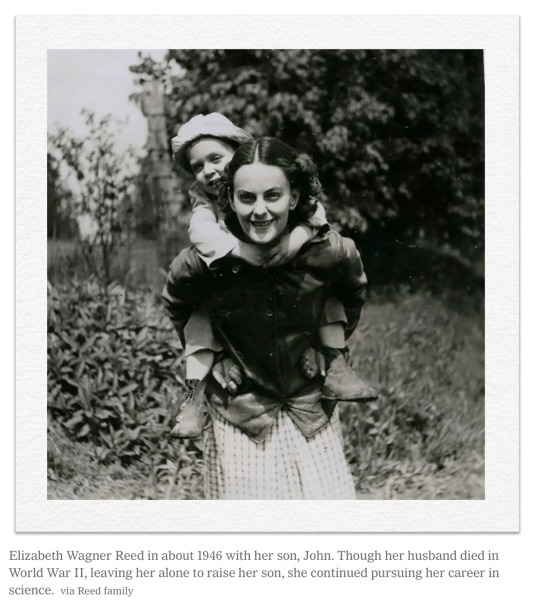
“She learned how to work really hard,” he added. “I remember her saying how much she loved school, partly because it wasn’t doing farm work.”
At the end of one summer, he said, she used some of her earnings to buy a book about wildflowers in Ohio — “her first purchase was a scientific book.”
She would go on to cultivate wildflowers in her backyard as an adult, volunteer at a wildflower arboretum in Minnesota and write about botany in scientific articles and in educational materials for children. Reed’s daughter, Catherine Reed, told Martín that her mother “loved nature, especially plants, and, wanted to be a scientist from a very early age.”
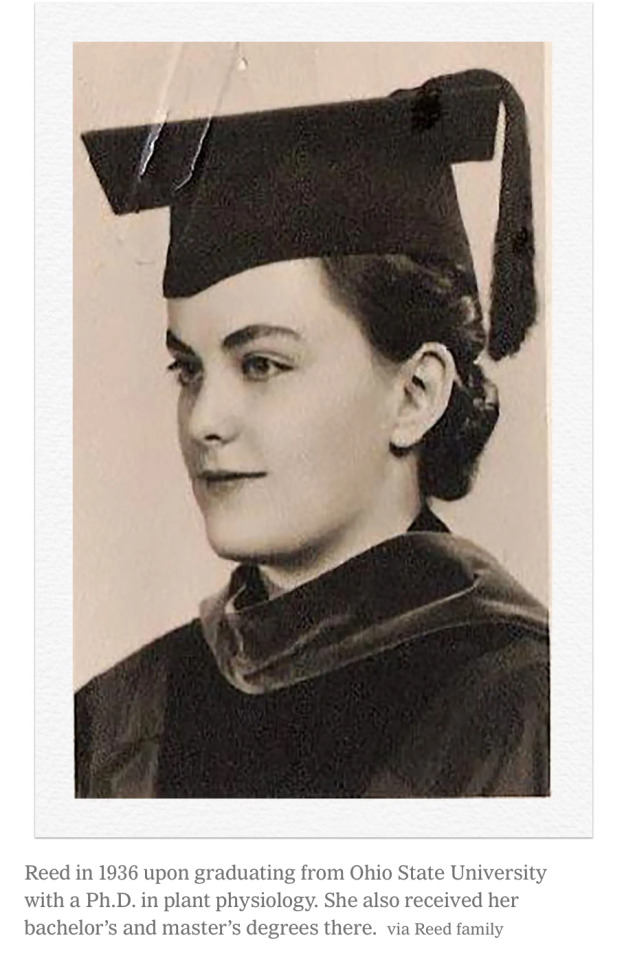
In 1933, Reed earned her bachelor’s degree at Ohio State University, where she also earned a master’s in 1934 and a Ph.D. in plant physiology in 1936. She put herself through school with a scholarship and by washing dishes and working in the cafeteria. In 1939 and 1940, she published her first two papers, one about the effects of insecticides on bean plants and the other about how various types of dusts affect the rate of water loss in yellow coleus plants by night and day.
In 1940, she married a fellow scientist, James Otis Beasley, and had a son, John, with him just after James left to fight in World War II in 1942. When her husband��was killed in the war the next year, she supported herself and her son by teaching at five different universities. “The first part of her life,” William Reed said, “was sheer determination.”
She began working with the geneticist Sheldon C. Reed, whom she married in 1946, and together they helped found the field of Drosophila population genetics, which uses fruit flies as a simple and economical method of studying genetics in a laboratory while offering important insights into similar species.
Soon after, the couple moved to Minnesota, where Sheldon was hired as the director of the Dight Institute of Human Genetics at the University of Minnesota in Minneapolis. Elizabeth was denied a job at the university, which cited rules against nepotism.
The Reeds went on to write a book about intellectual disabilities that analyzed data from 80,000 people and their families; the study, they said, was “one of the largest genetic investigations so far completed.”
They found that disabilities could be caused by genetic or environmental factors and could therefore be heritable. They also proposed — to controversy that still exists today — that such disabilities were preventable through education of the general public and voluntary sterilization or birth control of potential parents with low I.Q.s.
Though Elizabeth’s name was listed first as author, a letter of acknowledgment calling the couple’s work “truly magnificent” referred to them as “Dr. and Mrs. Reed.”
Reed was quite aware that her husband was receiving more credit, her son William said, but she never let it embitter her. In 1950, however, she published a paper on sexism in the sciences based on her study of 70 women working in the field. It found that marriage and childbirth decreased their productivity and sometimes even dissuaded them from continuing their careers. It led her to mentor women in the field through the advocacy group Graduate Women in Science.
“She was a scientist before it was popular for women to become scientists,” Nancy Segal, a psychologist at California State University known for her study of twins, said in an interview, “and she was a great role model for so many of us women postdocs at the time.”
In writing “American Women in Science Before the Civil War,”Reed corresponded with archivists and scoured card catalogs, journals and proceedings of associations and societies. In addition to recognizing Eunice Foote’s work almost two decades before other scientists did, the book included biographies of, among others, the astronomer Maria Mitchell; Ellen Smith Tupper, who was known as the “Queen Bee of Iowa” for her study of that insect; and the entomologist Mary Townsend.
Reed wrote that it was a testimony to the strengths of these women that they pursued science despite the fact that they were “often denied entry to colleges and unable to attain professional status.”
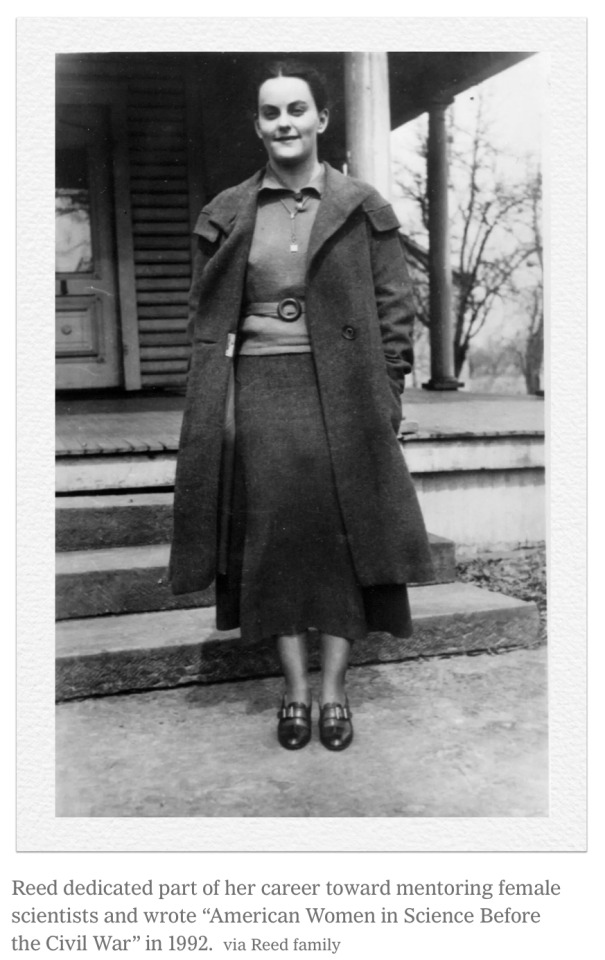
Reed also supported teaching children about science so that they would have the tools to solve what she called the “current crises of exploding populations and deteriorating environments.” She published papers about teaching proper scientific methods in schools and created curriculums with the University of Minnesota.
“Classrooms always house some living organisms,” she wrote, tongue-in-cheek, in the Journal of the Minnesota Academy of Science in 1969. “In many, unfortunately, all are of a single species, Homo sapiens. The population consists of many immature species (children) and a few adults, usually female (teachers). This makes for a certain homogeneity, but it can be alleviated by introduction of other living species, animal or plant.”
The fact that Reed was, like so many of her predecessors, lost to history is indicative of the pervasive sexism of her era. But women today continue to face hurdles in entering scientific fields. A report from the Massachusetts Institute of Technology this year found that “the underrepresentation of women in the science, technology, engineering, and mathematics (STEM) fields continues to persist,” with women making up only 28 percent of the STEM work force.
Like Reed, her daughter, Catherine, was a scientist, having earned a Ph.D. in ecology, but she ultimately became so disillusioned that she held a ceremonial burning of her degree and instead turned to artwork and championing her mother’s legacy. She published her mother’s book on American women in science on her website in about 2010. She died in 2021 at 73.
Elizabeth Wagner Reed died at 83 on July 14, 1996, most likely of cancer. She recognized her symptoms, but, knowing what the treatments would be like and, to her mind, the probable outcome, she never sought a diagnosis. (Sheldon Reed died in 2003.)
William Reed said there was no joy like taking a walk with his mother, who could describe every plant and animal they passed. She and Sheldon were avid bird-watchers (and occasional polka dancers), and the family spent many vacations at Lake Itasca, Minn., relaxing under old-growth Norway Pines.
Reed’s favorite flower was the showy lady’s slipper, the state flower of Minnesota, an orchid notoriously difficult to cultivate, like the careers of many of the women she wrote about. Its Latin name is Cypripedium reginae, with reginae meaning queen.
#Elizabeth Wagner Reed#Women in science#American Women in Science Before the Civil War#Books for women#Eunice Newton Foote#Margaret Rossiter#Matilda Effect#Matilda Joslyn Gage#Woman as Inventor#Marta Velasco Martín#Graduate Women in Science#Maria Mitchell#Ellen Smith Tupper#Mary Townsend
8 notes
·
View notes
Text
Maria Zhelezko pt. 50
49 notes
·
View notes
Text




hot women sketches…
#oc: kasia#i was rlly struggling with drawing for a while (still am) but trying a new brush and drawing what is therapeutic to me; women lol#my art#ramblings#sketches#god give me strength to finish at least 1 tho…#oh god marias foot is so long pls ignore tht LMAO
13 notes
·
View notes
Text




WTA 9 - 12 AS LYRICS FROM SONGS I HAVE SAVED [1 - 4] [5 - 8] [INSP]
MARIA SAKKARI [GRE] -> GAVE YOU EVERYTHING [THE INTERRUPTERS] JEĻENA OSTAPENKO [LAT] -> SO WHAT [P!NK] KAROLÍNA MUCHOVÁ [CZE] -> A BEGINNING SONG [THE DECEMBERISTS] DARIA KASATKINA [RUS] -> LIGHT MY LOVE [GRETA VAN FLEET]
#maria sakkari#jelena ostapenko#karolina muchova#daria kasatkina#wta tennis#penko's is a bit on the nose i will admit but i wanted to include the part of the chorus too#literally so what! she is a rock star! who gives a shit#also yes i did give karo my favorite song ever but in my defense it really does fit ok it does#i'm actually pretty pleased with all of these#i wanted maria's to include another verse line that i thought fit her really well but there wasn't space :(#and dasha's i was really proud of. i feel like verse chorus and hook all fit for different reasons#anyways. yeah#this is probably the last one i'm gonna do like this#i realize i sort of shot myself in the foot trying to do it with the rankings because it obviously is gonna change almost every week#and i can't keep up#and also i don't know all the players well enough outside of the top 12 or so to be able to do it accurately#that being said if you have a request for a player (with or without a song in mind) i could still give that a go!#cause thinking of these is really fun and i like the way most of them have come out#i will do atp players but fair warning i know way less about most of them lmfao#ALSO. yes i know these rankings are not official until monday. i don't care let me have this
21 notes
·
View notes
Text
“My little sister’s finishing school is putting on a pageant next week.”

“Let’s see if she can back up all that smack talk...”
As was expected of Von Karmas, Franziska’s letters comprised mostly of how much better she was doing at her studies than Maria did. Some claims were clearly exaggerated, but Maria took them all personally.
#;royal!au#franziska: *singing and dancing with the others*#maria: BIIII#xaos: . _ .#miles: :/#manfred: omg her foot was a quarter inch off mark she's disowned
2 notes
·
View notes